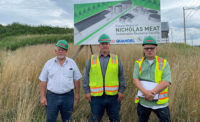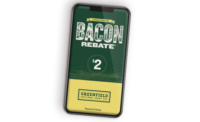American Ostrich Farms embracing sustainable growth
As the company has continued to scale, American Ostrich Farms is beginning to expand into retail grocery stores and independently owned restaurants.
Photos are courtesy American Ostrich Farms

The Kuna Idaho-based American Ostrich Farms’ journey to becoming a nationwide supplier of value-added exotic-yet-assessable ostrich meat products began in 2012, when company founder Alex McCoy was living in South Africa and first ate ostrich while training for an Ironman triathlon event. Realizing that ostrich could satisfy consumers’ red meat cravings while offering them a unique eating experience and nutritional benefits, McCoy left his career in finance, moved back to his home state of Idaho, and purchased a 120-acre property on the Snake River Plain.
Disruption and innovation
During the first years of the COVID-19 pandemic, American Ostrich Farms faced the same challenges as other small producers. Disruptions to the meat processing industry left them unable to harvest their livestock. Responding to the need, American Ostrich Farms began construction of a USDA-inspected processing plant adjacent to its ranch, said Jessica Roth, marketing manager at American Ostrich Farms. Dubbed Sustainable Meats, the operation opened its doors in May 2022, making American Ostrich Farms a 100% vertically integrated producer of USDA-inspected meat.
Sustainable Meats not only services American Ostrich Farms but also a number of other small and family-operated ranchers. In their first year, Sustainable Meats will process more than 1,000 ostriches, 1,000 lambs, and 750 head of cattle, Roth said. The operation offers USDA-certified organic and custom processing, as well as custom labeling and FSIS label submission, she said.
In collaboration with Sustainable Meats, American Ostrich Farms is conducting a feasibility study into producing value-added products, with a goal of developing ready-to-eat products that fit into consumers’ busy lives while delivering nutritional value, flavor, and environmental responsibility, Roth said.
Marketing messaging and channels
American Ostrich Farms positions itself as a leading national producer of ostrich filets, roasts, preformed burger patties, ground ostrich, and more, with the majority of their products being whole muscle cuts. The “hatch-to-harvest” operation allows American Ostrich Farms to provide consistent quality, Roth said.
For getting its products to its customers, American Ostrich Farms prefers the direct approach.
“American Ostrich Farms was an early adopter of the direct-to-consumer model,” Roth said.

Before Crowd Cow and Butcher Box, American Ostrich Farms shipped frozen products direct to its customers. American Ostrich Farms products are primarily sold through the company website, shipping to all 50 U.S. states.
Roth said that as the company has continued to scale, American Ostrich Farms is beginning to expand into retail grocery stores as well as a growing network of independently owned restaurants. American Ostrich Farms plans to supply multiple farmers markets beginning in spring 2023.
Roth said there are some growth opportunities for ostrich.
“As more Americans weigh the health and environmental considerations of red meat consumption — and as the market is seeing an influx of plant-based and, eventually, lab-grown substitutes — ostrich stands alone as an extremely palatable, nutritious and sustainable alternative that looks and tastes a lot like premium grass-fed beef,” she said.
Despite its categorization as an exotic protein, ostrich is remarkably approachable; easy to cook with, not at all gamey, and quite versatile, Roth said.
The meat also boasts a compelling nutritional profile.
“Ostrich meat is low in fat and cholesterol, rich in protein, iron, and B vitamins, and the only red meat recommended by the American Diabetes Association,” Roth said.
Sustainability
In keeping with its name, Sustainable Meats aims to redefine the relationship between meat processing and the environment, Roth said.
Pound for pound of boneless meat, ostrich production requires a third the amount of fresh water required for conventionally raised beef and 1/50th the land compared to grass-fed beef, she said. Ostrich only produces a tenth the greenhouse gas emissions.
“Ostriches have a superior feed conversion ratio, and raising them generates much less waste in terms of manure and greenhouse gas emissions,” Roth said. “These remarkable birds are drought-tolerant omnivores, which allows them to thrive in regions that would otherwise require significant irrigation.”
Beyond the inherent sustainability upsides of ostrich production, Roth said American Ostrich Farms minimizes waste by using every possible byproduct of their operation:
- fat is rendered and purified for use in moisturizing skin care products
- eggshells and feathers are sold for crafting and decor
- and low-volume cuts like liver and heart are made into freeze-dried pet treats.
The company sources feed, materials, and other resources locally to the greatest extent possible, and their hatch-to-harvest model means that transport-related emissions incurred to produce a final CPG product are nearly nonexistent, Roth said.
“Because they have control over the process, they capture more from each animal, vastly decreasing waste,” she said. “What is not used is composted and utilized to build the soil on their farm.”
With little municipal infrastructure available at their location, Roth said Sustainable Meats has had to engineer its own solutions to mitigate a variety of environmental impacts, with the company aiming for a holistic set of solutions to achieve greater environmental sustainability that can be a model for the small-scale slaughter and processing industry, Roth said.
“Wastewater generated by the plant is treated using a high-tech self-contained treatment system that results in effluent cleaner than what comes from a typical residential home,” she said. “The company hopes it’s holistic set of solutions to achieve greater environmental sustainability will be a model for the small-scale slaughter and processing industry.”
Looking for a reprint of this article?
From high-res PDFs to custom plaques, order your copy today!
.png?height=96&t=1647275041&width=96)






